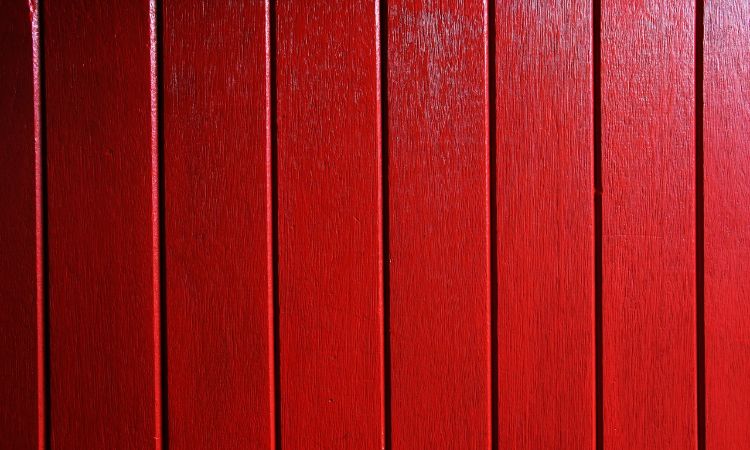Most painters (professionals, DIYers, and beginners) paint wood by brushing or rolling. We usually see and associate spraying with automotive and metallic substrates. However, can you spray paint wood?
Absolutely yes! Spray painting is a relatively new concept compared to other paint application techniques. That’s why most painters haven’t explored it on wood yet.
You can either spray paint wood directly or prepare the substrate first through cleaning, priming, sanding, and other affiliated practices.
In this article, I’ll talk you through:
- Spray Painting:
- How to Spray Paint Wood
- Different Approaches to Spray Painting
- The Situations that Call for Spraying
- Differences Between Conventional and Spray Painting.
I’ve also included:
- The merits and demerits of spray paint,
- The drying times on wood, and
- A few types/brands of spray paint that work best for wood.
I urge you to journey with me and stay focused throughout this short course for maximum benefit. Let’s begin.
What Is Spray Painting?
Before delving deeper, it’s essential to understand every aspect of the subject topic.
I’ll start with the definitions; what is spray painting?
It is a painting method that involves devices that spray coating materials (paint, varnish, primer, ink, etc.) through the atmospheric air to substrates.
The most prevalent types use compressed gas=mostly air=to disintegrate and direct the primer/paint particles.
Spray painting with pressurized air traces back to the 1880s, when it was used in the Southern Pacific Railway.
In 1887, a man named Joseph Binks invented a hand-pumped paint spraying tool that he used to apply whitewash to store walls.
Over the years, the tool named above saw minor improvements.
In 1949 however, there was a significant leap when Edward Seymour contrived aerosol spray painting!
It enabled painters to deliver paint and its congeners via pressurized aerosol cans.
Since the above breakthrough, spray painting has developed into an efficient and reliable paint application method; it has even gone mainstream and threatens to supersede conventional methods like brushing and rolling.
The inexorable progress of the technique has led to the development of numerous spray painting types, as detailed in the next segment.
Types of Spray Painting
The most popular types of spray painting are airgun spraying, HVLP spraying, and airless spray painting.
Other types include electrostatic spray painting, automated linear spray systems, automated flatline spray systems, air-assisted airless spraying, spray booth, etc.
Here is a brief description of some of the methods named:
AirGun Spraying
It is the application of paint to objects using an air-pressurized spraying gun.
The gun has an air compressor, nozzle, and a paint basin.
When you press/pull the trigger, a compressed air stream mixes with the paint to release fine/atomized paint.
An array of nozzle sizes and shapes lets you vary paint pattern and consistency.
The three most familiar nozzle types are the hollow cone, full cone, and flat stream.
High Volume Low Pressure (HVLP)
The high volume, low-pressure paint sprayer functions similarly to conventional spray guns, which use pressurized/compressed air to atomize the paint.
The difference is that HVLP utilizes lower pressure and higher air volume than its conventional counterpart to disintegrate and move paint.
It results in higher paint proportions landing on the target, minimal overspray, and reduced air pollution.
A regulator is often needed to lower the air pressure of a regular compressor to the level of the HVLP paint sprayer.
Alternatively, you can use a turbine unit to propel the air, eliminating the need for an airway connection to the compressor.
The turbine unit usually contains a motor similar to the one for a vacuum cleaner but reverse mounted.
Electrostatic Spray Painting
Electrostatic spray painting involves the electrical charging of atomized paint.
The spray particles contain equally-like charges that make them repel each other and spread out evenly when released from the nozzle.
The substrate is grounded or charged oppositely to the disintegrated paint; this creates an attractive force that enables the paint to adhere firmly and evenly to the surface.
The above form of spray painting has the advantage of even surface layering and minimal paint wastage, thanks to the high transfer efficiency.
It also allows the paint to access hard-to-reach areas.
The three principle charging methods are:
- Direct charging
- Post-atomization charging
- Tribo charging
Automated Linear Spray Systems
The above method is used in mass wood-processing plants to achieve a high painting rate with minimum personnel.
As the name suggests, it’s an automated system with a paint-saving mechanism that recycles paint that has missed the target for reuse.
The substrates in a linear spray system are often laid flat on a conveyor belt before feeding into the spraying chamber.
The spraying area has automated spray guns positioned above.
When the substrates are directly below the spray guns, the sensors set off a cascaded process that ultimately sprinkles paint.
Automated Flatline Spray Systems
Flatline spray systems function similarly to linear spray systems in mass production and loading on a conveyor into a painting chamber.
The difference is that flatline machines paint complex-shaped materials like drawer fronts and kitchen cabinet doors.
Their spray guns are also fitted in such a way that they make circular and back & forth motions; this makes them access all the spots and furrows of the materials.
The above systems are often expansive and can paint kitchen cabinets, doors, composite boards, and other wooden products.
Air Assisted Airless Spraying
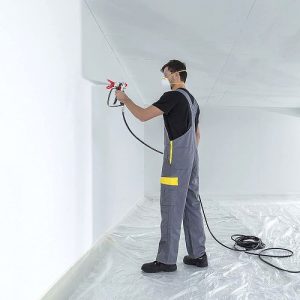 The above combines hydraulic pressure and air pressure adding up to a range of 300 to 3000 pounds per square inch (psi) to atomize the paint.
The above combines hydraulic pressure and air pressure adding up to a range of 300 to 3000 pounds per square inch (psi) to atomize the paint.
The machine is capable of rapid paint discharge and decent transfer efficiency, making it suitable for industrial or large-scale use.
The airless pump’s high fluid/hydraulic pressure enables you to spray paint heavier substrates beyond an air spray gun.
Compressed air is injected into the paint through an air cap/air nozzle. It makes the spray particles finer.
Pros and Cons of Spray Painting
Spray painting, like other forms of painting, has advantages and drawbacks.
On a cost-benefit analysis, the upsides outdo the downsides.
That’s why the technique has been on an upward trajectory regarding popularity.
This segment highlights some of the pros and cons of spray painting.
Pros
- It results in faster drying times than other painting techniques.
- Using sprayers requires less effort than other methods; it’s due to the mechanization of the process.
- Spray painting produces even coatings with no brush marks.
- The spray guns and cans are ergonomically built for a more comfortable and enjoyable user experience.
- Spray painting is less messy.
- This painting technique takes less time to cover large surfaces; it facilitates faster project completion.
- It lets you choose your desired spray pattern thanks to the wide range of spray gun tip designs.
Cons
- Spray painting is only practical in calm weather; windy conditions considerably undercut its efficiency.
- The technique is prone to the orange peel effect; due to wrong spray gun setup, rapid thinner evaporation, and application of excess paint. The finish resembles the rind of an orange fruit.
- It results in paint wastage and air pollution due to overspray.
- There is a high maintenance cost for the spray guns; due to regular cleaning, oiling, and replacing broken/worn-out parts.
Is It Better to Spray Paint or Paint Wood?
Painting, in this case, is the same as conventional painting, i.e., brushing and rolling.
Thus far, you have an idea of what spray painting is, thanks to the earlier definitions and the pros and cons just mentioned above.
That said, is it better to spray paint or paint wood?
In truth, none of the two techniques surmount the other.
In some situations, spray painting is better, while painting carries the day in others.
What really matters are the prevailing circumstances; these include the weather conditions, the type of finish you desire, health risks, costs, project size, wood condition, etc.
Here is an in-depth look at how the above circumstances influence a better painting technique:
Weather Conditions
Painting will be a better choice than spraying if you’re in a continually windy environment because the wind blows away aerosolized paint.
This results in low transfer efficiency, paint & energy wastage, and distortion of paint patterns.
On the other hand, spray painting works better for those residing in abodes with calm or tranquil weather conditions.
In this case, the sprayed paint lands on your wood substrate as directed, and the paint pattern from the spray gun tip won’t be distorted.
Desired Finish
Spray painting gives you more room to manipulate the character of your finish.
It lets you achieve either a smooth or textured finish known as the orange peel effect.
An orange peel finish has a texture that looks and feels like orange skin; you can achieve it either intentionally or by accident.
Painting also gives a smooth finish, but it’s often more challenging as you have to go over the painted surface several times to eliminate brushstrokes.
You also need to watch out for drips to prevent the formation of streaks on the wood.
Lastly, when painting, you can only attain a good finish when you brush or roll along the wood grain.
On the other hand, spray paint gives you the liberty to paint in any direction; the atomized paint will still land on the wood for a good finish.
Project Size
Spray painting works better than painting for large projects.
It’s because the former covers large surfaces per unit of time and is less tedious, while the latter consumes more time and is more labor-intensive.
In spraying, you only need to direct the spray gun nozzle to the wood and pull the trigger to effect painting; the technique is mechanized, so you’ll use less effort.
In painting, you have to dip the paintbrush or roller into the paint reservoir or roller tray, shake off the excess against the side of the container, then apply the paint physically.
You also need to smooth over the wooden surface; it’ll drain your energy if you work on a big project.
For smaller projects, you can use both techniques, but painting gives you more control and a more detailed finish.
Note: As I’d intimated, the word paint, when used as a stand-alone, translates to conventional/ordinary methods which use paintbrushes or rollers; keep this in mind throughout the writeup. Let’s carry on.
Costs
Spray painting costs more than painting because it involves purchasing machines (spray gun and compressor).
Painting only involves buying paintbrushes or rollers.
Some spray painting equipment like airless spray guns, have low transfer efficiencies leading to wastage of paint; this increases the costs further.
On the contrary, painting shows minimum paint wastage. The only way it can cause wastage is through the leftovers from a completed project.
However, you can recycle the leftovers for future use.
There is a famous adage that says, “time is money!” There’s no better illustration of this than comparing spray painting with painting.
If you look at it from the above time-based perspective, spraying costs far less.
The spray guns take shorter durations to complete massive projects; this reduces the cost of spending too much time on a single task; you could be elsewhere involved in other productive undertakings.
Health Effects
You’re more inclined to get respiratory problems when spraying, especially if you’re allergic.
It’s due to the operating mechanism of paint sprayers; atomized paint lingers in the surrounding air for some time.
If you inhale it for long, you might feel nauseated.
Painting predisposes you to problems involving skin reactions, especially for hypersensitive individuals.
It’s because of the close handling during mixing and the actual paint application.
To prevent the above health risks, always put on all the safety gear when handling paints; they include a respirator, goggles, a pair of gloves, and safety clothing.
It’s also important to note that the above health risks are pretty rare, and if by chance they set in, they are usually self-limiting, lasting only a day or two.
Condition and Value of the Wood
Spray painting unprimed wood is easier than painting it under the same condition.
It’s easier because you don’t have to prime, and you’ll need fewer coats. However, its adhesion will be highly undercut.
Painting works better if you need better adhesion, but it trades off with more time consumption and labor demand.
If the substrate is a valuable piece of furniture, like art furniture and sculptures, painting will work better as it allows you to put in the details and gives you more room to avoid mistakes.
If the substrate is ordinary furniture like tables, kitchen cabinets, and cupboards, spray painting will work better for you.
Is a Primer Needed for Spray Paint?
Traditionally (using conventional painting methods), it is better to prep wood surfaces before painting.
Prepping involves cleaning, sanding, and priming. However, is a primer needed for spray paint?
Yes, a primer is needed for spray paint, although less so than other painting methods.
Generally, all painting undertakings require priming; it’s a pretty convenient baseline.
Priming wood before spray painting helps in the following ways:
- It prevents bleed-throughs from knotty wood like pine
- It improves paint adhesion to the substrate
- Priming reduces the number of paint coats needed
- It hides surface imperfections like stains
- Priming prevents water damage and mildew/mold growth
- It covers pores, thereby leveling the wood surface
From all the above points, it’s easy to gather that spraying without priming is highly consequential to the wood.
So I advise you to just prime for the sake of excellent results.
What Kind of Spray Paint Can You Use on Wood?
As earlier mentioned, the advent of spray painting and its quick embrace by painters has led to increased production; they seem to have sprouted.
It means there are many spray paint types in the market; you need to know which kind suits your wooden substrate.
Concerning the above, what kind of spray paint can you use on wood?
First, there are two broad options from which you can choose.
The first involves ready-made spray paints in spray cans, and the second is ordinary paint which you can buy, mix and load into a spray paint machine/spray gun.
I prefer the second option because it enables you to formulate the thickness, color, and paint type you want to use.
Additionally, using a spray gun is versatile in terms of paint patterns and also covers large surface areas.
Even so, ready-made spray paints (the ones in spray cans) work so well if you know what you want regarding color, paint thickness, and whatnot.
They have positive feedback and solid backing from customers.
That said, I’ve done online research, looked at clientele reviews, and drawn from personal experience to narrow down to the following outstanding spray paint products:
Rust-Oleum Matte Painter’s Touch
The above is a product made by Rust-Oleum®, a subsidiary of RPM International Inc.; it is headquartered in Vernon Hills, Illinois.
Rust-oleum is renowned for making protective coatings and paints for industrial and home use; the matte painter’s touch paint is among its frontline best.
The paint is available in spray cans and pint-sized cans that you can load into spray guns.
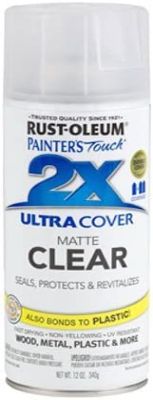 It is a multi-purpose paint for exterior and interior surfaces, including wood, masonry, metal, plastic, unglazed ceramic, and plaster.
It is a multi-purpose paint for exterior and interior surfaces, including wood, masonry, metal, plastic, unglazed ceramic, and plaster.
The formula is oil-based for improved durability and wood surface protection.
These are its selling features:
- It has a wide surface coverage of up to 12 square feet per can.
- The paint dries faster than other oil-based formulas.
- It forms a waterproof coat that makes the wooden surface easy to clean, mildew/mold-resistant, and stain-resistant.
- This product produces a matte finish that looks smothered but classy.
- The low-sheen finish also helps to hide wood imperfections.
- Its spray can is ergonomically designed for a comfortable painting experience at any angle.
- The painter’s touch paint comes in many colors that allow you to choose your taste.
Krylon Fusion All-In-One Spray Paint
Sherwin-Williams Company manufactures the spray named above paint.
It’s an American company headquartered in Cleveland, Ohio.
The company stretches far back to the 19th century, so it’s predictably well-versed in coating and paint matters.
Krylon, and several other paint brands, fall under the consumer brands group segment of Sherwin-Williams.
The fusion all-in-one subtype is suitable for external/internal projects, and it works on wood, metal, plastic, ceramic/plaster, masonry, and glass substrates.
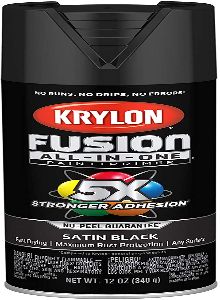 The spray paint is long-lasting and can be used to paint anew, recolor, or restore any project.
The spray paint is long-lasting and can be used to paint anew, recolor, or restore any project.
Other desirable features are:
- It dries quickly: 20 minutes to the touch and 2 hours for recoating.
- The fusion all-in-one product contains both paint and primer; this eliminates the need for priming before painting.
- The spray can is ergonomically built and equipped with a big-button tip, allowing you to spray comfortably from many positions.
- This paint gives a satin sheen that’s subtle with a classy appearance.
- It comes in 12 oz bottles/cans with a wide coverage of up to 25 sq. feet.
- Krylon spray paint disintegrates into a fine mist with excellent leveling properties for a smooth finish.
- The product is uniquely-formulated to avoid the orange peel effect on substrates.
INSL-X Cabinet Coat Enamel
INSL-X® is the master of specialty paints and coatings.
Its products have a significant acclamation in all painting quarters, including commercial property managers, professional painters, and homeowners.
Benjamin Moore and Co. acquired the company, but it still sells its products as an independently-owned retailer.
Using an airless spray gun or an air paint sprayer, you can spray the above product on wood.
The paint works perfectly on shelves, kitchen & bathroom cabinets, furniture, crown moldings, and trims.
It is a urethane acrylic enamel paint, so it has excellent adhesion even to hard-to-coat substrates.
The paint also has an almost unbeatable durability profile.
Other outstanding features include:
- It has a wide surface coverage of 350-450 square feet per gallon.
- The paint has low VOC levels making it innocuous to humans and eco-friendly.
- INSL-X enamel paint produces a low odor that quickly disappears after painting, making it comfortable for the user and people within the surrounding environment.
- This paint is resistant to scuffing, chipping, and peeling.
- It gives a semi-gloss finish that stands out in terms of aesthetics.
- The paint comes packed with a can opener and stirring stick to aid in the unfastening and mixing processes.
- INSL-X spray paint forms a smooth, impervious layer that resists water, grease, and common stains.
When spraying the above paint, do so in calm weather and a temperature range of 50º-90ºF for optimal transfer efficiency and sufficient drying.
For good measure, INSL-X® also makes masonry coatings, traffic paint, specialty primers, swimming pool paints, and field-marking paint.
The broad catalog is a benchmark for its degree of success and professionalism.
Check Latest Price
Can You Spray Paint Wood Furniture Without Sanding?
It’s a universal truth for all painters that sanding is often time-consuming, tedious, messy, and can elicit allergic respiratory reactions.
However, it’s often quite important as a painting preliminary.
Considering the two statements, can you spray paint wood furniture without sanding?
You can! Sanding is only crucial in the following scenarios:
- When the wood is heavily damaged (e.g., warping, indentations, and scratches),
- When removing an existing paint (especially oil-based paint),
- To remove raised wood grains (when the wood surface is too rough),
- To remove wood decolorations (due to fungal growths or chemical spills).
Besides the situations mentioned above, you don’t need to sand the wood before spray painting; priming is all it takes to make the substrate ready to receive paint.
What Happens If You Don’t Sand Before Painting?
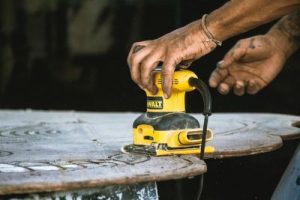 Let’s say you want to paint wood, but you’re pressed for time, or the substrate has a large surface area.
Let’s say you want to paint wood, but you’re pressed for time, or the substrate has a large surface area.
Then, you solve this by skipping some prepping protocols like sanding.
How will the finish appear? Or, to be precise, what happens if you don’t sand before painting?
Failing to sand has different repercussions depending on the status of the substrate.
If the wood is new, bare, smooth-textured, or without imperfections, you can avoid sanding; it won’t compromise the top coats.
However, you must sand if the wooden workpiece has major defects like scratches, burns, indentations, indelible stain marks, or an uneven surface.
Otherwise, the following will happen:
- There will be poor paint adhesion: this leads to peeling.
- It makes paint application difficult because the wood is porous and uneven, yet you must avoid the defects to prevent injuries.
- Water will accumulate on the substrate: this leads to damage from rot.
- It will lead to damp conditions conducive to mildew and mold growth.
- It impairs the aesthetics of the painted substrate: due to discolorations and stain spots.
- An unsanded surface is dangerous as it can cause injuries, especially to children: due to surface unevenness and defects.
The ultimate consequences of the above are reduced paint durability, paint wastage, and increased costs of replacements/repainting.
Therefore, I advise you to sacrifice your time and energy to sand. The investment is a one-time affair, but it pays long-term dividends.
How to Spray Paint Wood
We’ve had a lengthy and informative discussion on every aspect of the title; the only missing bit is how to spray paint wood.
Buckle up as I take you through this action-packed segment.
Requirements
- Paint
- Paint sprayer (air spray gun or airless spray gun) and compressor
- Vacuum cleaner
- Primer
- Plastic drop cloth
- Safety gear (respirator, a pair of latex gloves, safety goggles)
Procedure
First, free your working station by removing unwanted materials and ensuring proper air circulation.
Then, cover the floors and immovable stuff using the plastic drop cloth; this prevents staining from paint overspray.
Next, put on all the safety gear; they prevent accidental ingestions, eye irritation, inhalations, and irritation due to skin contact with the paint.
Then, sand the wood surface using appropriate sandpaper.
If you’re handling a big project, you can use an electric sander or rent a bigger sanding machine from your local depot.
I’ve used the term “appropriate sandpaper” because our desired wood textures vary; some like it slightly smooth, while others prefer rougher surfaces.
If you want the former, use fine-grit sandpaper; if you want it coarse, use lower-grit sandpaper.
After sanding, vacuum away the accumulated dust.
Then, open your primer, stir it, and load it into the spray gun; follow the user’s guide when loading paint into and using the spray gun.
Next, spray the primer on the substrate and let it dry for the duration indicated by the manufacturer.
When using the paint sprayer, hold and maintain a distance of 8 to 15 inches between the nozzle and the wooden surface.
Let the primer dry for the specified durations as you prepare for the next step, i.e., painting.
Remember to clean the paint sprayer and empty the paint cup of the remaining primer before setting it up for painting.
Next, open up and mix/stir the paint before loading it into the sprayer’s paint cup.
If the paint is too thick, thin it using a suitable paint thinner.
Afterward, hold the paint sprayer 8 to 15 inches from the substrate and pull the trigger to release the paint. Maintain the spraying distance and speed for an even finish.
Let the paint dry for the duration recommended by the manufacturer.
Apply a second paint coat using the same procedure as the first.
You should put in this coat on an as-needed basis, meaning if the first coat holds up well, you can stop there.
Let the paint dry again before removing the plastic drop cloth.
The above is all you need to do to give your wooden workpiece a new, fresh look. It’s simple, isn’t it?
The last part involves cleaning your working station and the air sprayer. The working area shouldn’t be much of a problem if you used a drop cloth.
But if there are accidental spatters, clean using a water-soaked rag or turpentine/mineral spirits for oil-based paints.
For the spray gun, you should disassemble it and clean all its parts thoroughly. Then, let them dry before storage.
Here’s a Video On How to Spray Paint Wood:
Can You Spray Paint Painted Wood?
Not all wooden substrates are the same; some are bare, some have been painted previously, some have different textures, and they also have differing paint absorbance profiles.
You should always anticipate any of the situations named above. Take, for instance, an already painted wooden workpiece; can you spray paint it?
It’s a yes with limits. If you’re planning to apply the same paint color as the existing one, go ahead and spray paint without following the main prepping procedures.
You only need to clean before applying.
What if the incoming paint is the same color as the current paint, but the said existing paint is heavily peeled or scuffed?
In this scenario, you must follow the standard prepping protocols before spraying. The preliminaries are sanding, cleaning, and priming.
Other situations that warrant surface prepping before spray painting the painted wood include:
- When the new paint is of a different type from the initial one, e.g., when replacing an oil-based paint with its latex counterpart
- When the wood surface appears old: sand and prime it first to make it look new, then spray paint.
- If you want a better paint adhesion: for improved durability and to avoid the orange peel effect
- When the wood or furniture is riddled with defects
How Long Does Spray Paint Take to Dry On Wood?
Paint drying times differ depending on several factors, including paint type, method of application, type of substrate, environmental conditions, coat thickness, etc.
Conforming to the title, how long does spray paint take to dry on wood?
Spray painting generally takes less time to dry, both to touch and to recoat.
To put it into perspective, I’ll compare the drying times for spraying with brush-painting/conventional painting.
Spray paint takes around 3 hours for water-based paint, while brushing takes around 4 hours for the same paint.
Oil-based paints dry after around 20 hours when sprayed and around 24 hours when brushed/rolled.
It’s also important to know that the drying times vary depending on the weather conditions, thickness/number of the paint layer, paint viscidity, and type of wood.
The times I’ve mentioned above are averages; they often show slight positive or negative deviations in real-life applications.
Conclusion
To conclude, keeping abreast of the innovations, developments, and updates that breathe new life into the painting domain is essential.
It’s a huge niche, so it’s never short of new ideas; they come from up/down and across the globe.
Currently, spray painting is under a lot of attention from professionals, painting hobbyists, and amateurs; don’t be left out!
The article’s focal point is on wooden substrates; so…
Can You Spray Paint Wood?
You get my nod! You can spray paint wood.
It’s a new concept that has jumped through all the painting hoops with great success.
I’ve detailed the most crucial aspects of the topic in question, including:
- The definition of spray painting
- Types of spray painting
- Differences between painting and spray painting,
- How to spray paint, and
- The best spray paint brands.
I’ve also covered adjunct aspects that include the pros and cons of spray painting, the need for priming/sanding before spray painting, and how long a spray paint takes to dry on wood.
In short, I’ve left no stone unturned, so the onus is on you to take some time and read wholly but keenly.
You can also look at the brands I’ve filtered out for you and acquire whichever fits you.
The final and all-important decision is yours.
If you follow all of the above, you’ll attain pro-level spray painting skills, and rest assured to prime and finish any wood substrate successfully.
From my end, this is one of the best topics I’ve covered. In that regard, I bow out feeling better than when I started the article.
